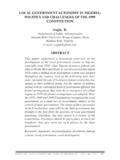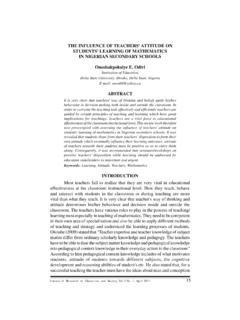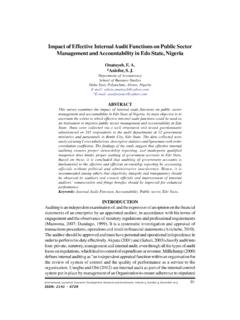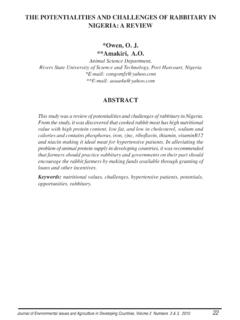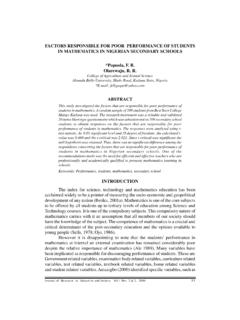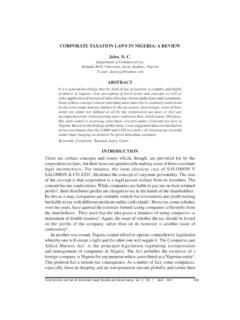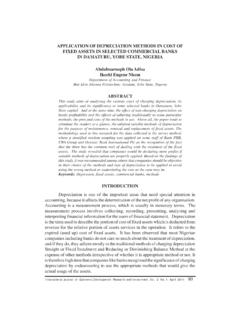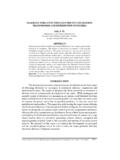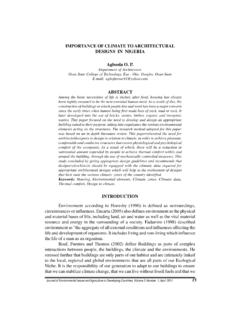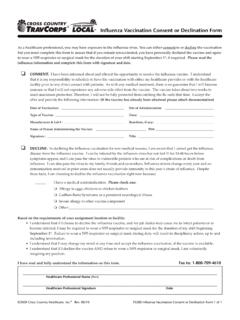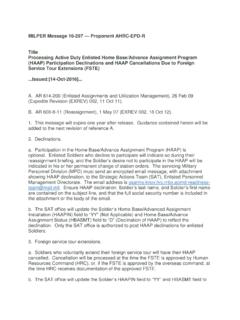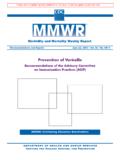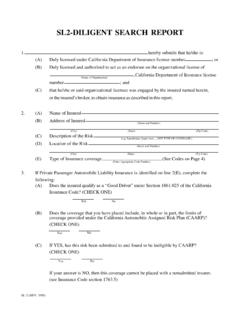Transcription of APPLICATION OF MINIMUM CURVATURE …
1 International Journal of Engineering and Mathematical Intelligence, Vol. 1 Nos. 1 & 3, 2010 82 APPLICATION OF MINIMUM CURVATURE METHOD TO wellpath CALCULATIONS Richard Amorin *Eric Broni-Bediako University of Mines and Technology, Tarkwa, Ghana *E-mail: ABSTRACT A major drawback of directional and horizontal well drilling is the numerous complex computations required to be done while planning a well. These computations are very stressful and time consuming especially when done manually. The aim of this study was to assess the APPLICATION of MINIMUM CURVATURE method to wellpath calculations. Therefore this study developed a user friendly Excel Spreadsheet program that would make the computations of the well trajectory parameters easier, faster and accurate. An Excel Spreadsheet program was developed employing the MINIMUM CURVATURE method (and for other five methods ) for wellpath design and planning.
2 This would help increase the usage of these trajectory methods especially the MINIMUM CURVATURE method. The program was able to provide pictorial views both in the vertical and horizontal plane of the trajectory of the drilling bit's position in the wellbore. This would therefore help to minimize risk and uncertainty surrounding hitting predetermined target. This is possible because deviations can easily be detected and the necessary directional corrections or adjustment be initiated to re-orient the drilling bit to the right course before (planning process) and during the drilling operations. Keywords: Complex computations, Excel Spreadsheet program, MINIMUM CURVATURE method NOMENCLATURE Symbol/Acronym Description Ai, , or Ф Azimuth BHA Bottom Hole Assembly BRT Below Rotary Table DFE Derrick Floor Elevation Di, DMi, TVD True Vertical Distances DOT Downhole Orientation Tool I, i, Inclination Angles LA Lead Angle MWD Measurement While Drilling ND North Displacement Ri, ri Radius of CURVATURE RKB Rotary Kelly Bushing STL Survey Tool Length TOD Turn Off Depth Xi or MD Measured Displacement , DL Dogleg Severity Angle E, Mi Change in Easting N, Li Change in Northing V Change in Elevation International Journal of Engineering and Mathematical Intelligence, Vol.
3 1 Nos. 1 & 3, 2010 83 INTRODUCTION Directional drilling is the science and art of deviating a wellbore along a planned course to a subsurface target whose location is a given lateral distance and direction from the vertical (Bourgoyne, Millheim, Chenvert, Young, 1991). Directional drilling and horizontal wells represent an efficient way to achieve or hitting special targets that may or are very difficult to reach using vertical wells (Tarek, 2000). Directional drilling is relatively done to increase production rates, control water and gas conning, control sand production and increase recovery rate (Bourgoyne et al, 1991). There are many reservoirs which cannot be tapped by vertical wells or would be uneconomical to exploit with vertical wells (Bourgoyne et al, 1991). Other reservoirs are also characterized by vertical permeability or the pay zones may be very thin and producing with vertical wells would require quiet a number of them which would make vertical wells to be very uneconomical in such situations.
4 The APPLICATION of vertical wells in such formations could also result in lower ultimate recovery (Tarek, 2000). In such low permeability formations, the only way out is to use directional and horizontal well technology which has over the years proved to enhance ultimate recovery (Bourgoyne et al, 1991). Due to the more economical nature of directional and horizontal wells over vertical wells in most cases, they are mostly the preferred technology in offshore drilling technology (Bourgoyne et al, 1991). A major drawback of directional and horizontal well drilling is the numerous complex computations required to be done ahead of time before drilling resumes and also during drilling operations (Sawaryn, 2005). These computations become very stressful and more complex when done manually. The programs available in the market used for these computations are usually very expensive to acquire, but the development of a user-friendly Excel Spreadsheet program which employs the MINIMUM CURVATURE method for wellpath planning would help minimize the stress and time in executing these complex computations.
5 More importantly, an Excel Spreadsheet program is very flexible and can easily be modified or updated at any point in time to meet the needs of the industry. The objectives of this study are: (i) to develop a user friendly Excel Spreadsheet program that will make the computations of well trajectory parameters easier, faster and accurate, and (ii) use the Excel Spreadsheet program to evaluate and compare some of the survey calculation method available for the industry. These methods are the Tangential, Averaging Angle, Balanced Tangential, Mercury, Radius of CURVATURE and the MINIMUM CURVATURE methods . Directional wells are drilled with intentional control to hit a pre-determined target with the aid of controlling inclination (angle) and azimuth (direction). Directional drilling is drilling in three dimensions (3-D) (Bourgoyne et al, 1991). Directional drilling has proven technically and economically feasible in a broad range of geologic settings, including tight gas, heavy oil, and coalbed methane (Molvar, 2003).
6 This method is proven to substantially increase producible reserves of oil and gas. Because the increased productivity of directional drilling compensates for additional costs, directional drilling is often more profitable than vertical drilling (Molvar, 2003). Some of the reasons for or applications of directional drilling are listed below; (Bourgoyne et al, 1991, Osisanya, 2009). International Journal of Engineering and Mathematical Intelligence, Vol. 1 Nos. 1 & 3, 2010 84 (a) For Economics/Environmental Issues (b) To drill multiple wells from artificial structures, field development offshore in deep waters or remote locations (c) To sidetrack any obstruction ('junk') in the original wellbore (d) To explore for additional producing horizons in adjacent sectors of the field (e) To re-drill well (f) To put out fire resulting from blowout (relief wells) (g) To drill to reservoirs avoiding inaccessible locations (h) For Salt Dome drilling (i) For Fault controlling Fundamental Concepts and Basis of Directional Drilling For any directional drilling, three components are measured at any given point in the wellbore in order to determine its position.
7 The technique of measurement of these three components is termed a survey. The depth, drift angle (inclination) and azimuth are measured (Osisanya, 2009). There are over eighteen methods available for calculating or determining the trajectory of a wellbore (Bourgoyne et al, 1991). The main difference in all the techniques is that one group uses straights lines approximations and the other assumes the wellbore is more of a curve and is approximated with curved segments. Listed in table are comparisons of six of the methods in ascending order of preference and also complexity of techniques; Table 1: Comparison of accuracy of the six methods (Bourgoyne et al, 1991) Method TVD Diff. From Actual (ft) North Displacement Diff. From Actual (ft) Tangential Balanced Tangential Mercury Angle -Averaging Radius of CURVATURE 0 0 MINIMUM CURVATURE 0 0 The tangential method shows considerable error for the northing, easting and elevation which makes it no longer preferred in the industry (Bourgoyne et al, 1991).
8 The differences among the average angle, balanced tangential, radius of CURVATURE and MINIMUM CURVATURE are very small and any of the methods could be used for calculating the trajectory. Because the MINIMUM CURVATURE method is the most widely preferred method in the oil industry, more emphasis would be laid on in the next section than the other methods . The Tangential, Balanced Tangential, Mercury and Angle averaging, are applicable to wellbore trajectory which follows straight line course whiles the Radius of CURVATURE is strictly applicable to a wellbore trajectory that follows a curved segment. The MINIMUM CURVATURE method is applicable to any trajectory path. THE MINIMUM CURVATURE METHOD In all the MINIMUM CURVATURE methods , two adjacent survey points are assumed to lie on a circular arc. This arc is located in a plane and the orientation of which is defined by known inclination and direction angles at the ends of the arc (Bourgoyne et al, 1991).
9 In 1985, the MINIMUM CURVATURE method was recognized by International Journal of Engineering and Mathematical Intelligence, Vol. 1 Nos. 1 & 3, 2010 85 the industry as one of the most accurate methods , but was regarded as cumbersome for hand calculation . The emergence of well-trajectory planning packages to help manage directional work in dense well clusters increased its popularity. With the APPLICATION of the MINIMUM CURVATURE method, toolface, interpolation, intersection with a target plane, MINIMUM and maximum true vertical depth (TVD) in a horizontal section, point closest to a circular arc, survey station to a target position with and without the direction defined, nudges, and steering runs can be determined (Sawaryn, 2005). PROGRAM DEVELOPMENT IN EXCEL SPREADSHEET The data input interface in the Excel Spreadsheet contains three sections which are; 1 The Well description Input Data section requires the input of description data such as Company Name, Field Name, Well Name, Reservoirs/Fluid type and name of the Drilling Engineer in charge of operations.
10 2 The Adjustment/Correction Input section requires the input of adjustment or correctional data values such as the Lead Angle and or The Magnetic Declination adjustment value(s). These values are needed for the adjustment of the spatial data. The lead and magnetic declination angles must be in degrees. The directions for both the lead and magnetic declination angle must be specified. If the bit walk is to the right, the word 'Right' should be selected from the drop-down menu otherwise the word 'Left' should be selected for left walk of bit to make the necessary adjustments. The same approach is applicable to the magnetic declination adjustment. If the magnetic declination is to the West, the word 'West' must be selected otherwise the 'East' should be selected for East magnetic declination. Figure 1(a): A representation of the geometry of the MINIMUM CURVATURE method (b): A representation of the MINIMUM CURVATURE ratio factor (RF) (Bourgoyne et al, 1991).
